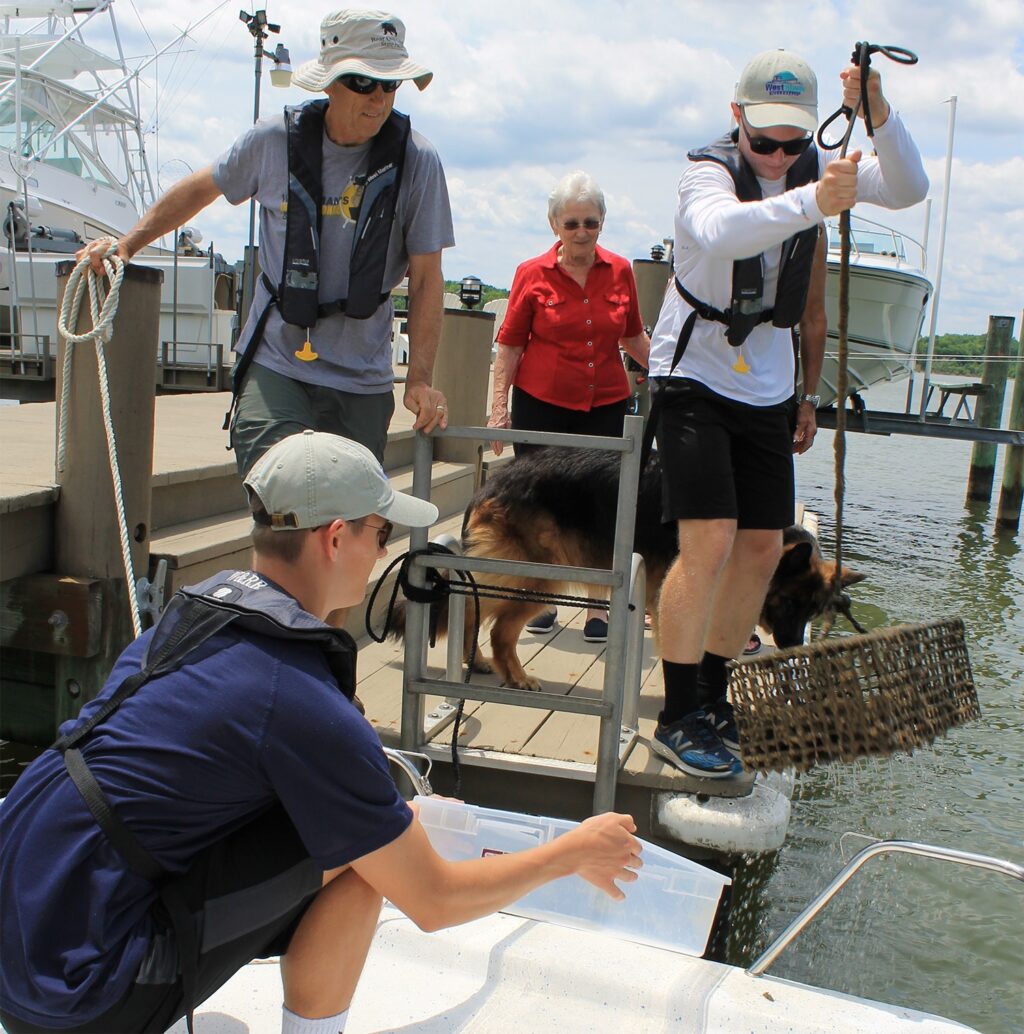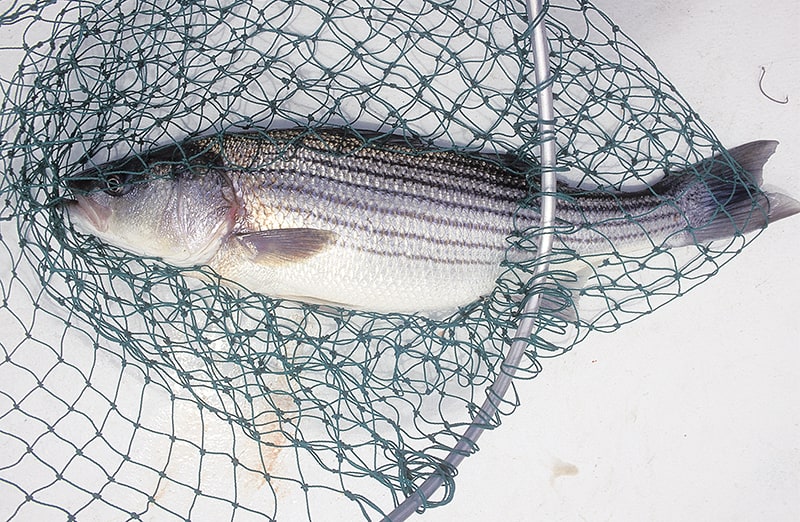When the Bay’s oyster population was in its prime, oysters filtered the entire volume of water in the Chesapeake Bay—about 19 trillion gallons—in a week. Today, the much smaller number of remaining oysters take almost a year to accomplish the same task. Oysters are critical to the health of ecosystems wherever they are found and the lack of oysters is a contributing factor in the environmental decline of the Bay. But individuals all around the Bay are participating in a grassroots effort to reverse this trend.
If you have access to a dock and want to help improve the health of the Bay, it’s time to consider getting involved in the interesting and rewarding hobby of oyster gardening.
This year, nearly 700 volunteer oyster gardeners in Virginia working with the Chesapeake Bay Foundation (CBF) grew and returned a record 146,000 live oysters to protected reefs in the Bay. These oysters are helping reverse the Bay’s environmental decline by filtering as much as 7.3 million gallons of water daily, sequestering phosphorus and nitrogen to grow their shells, and creating habitat critical to mud crabs, fan worms, sea squirts, skilletfish, barnacles, and many other species.
Oyster gardening is happening in nearly all parts of the Bay, contributing to the Chesapeake Oyster Alliance’s initiative to add 10 billion new oysters in Maryland and Virginia waters by 2025.
The population of the iconic oyster of the Chesapeake Bay (Crassostrea virginica) is currently estimated to be less than 2 percent of its historic high. When Europeans first arrived on the Chesapeake Bay, it was quite literally full of oysters. A Swiss visitor in 1701 reported that his boat ran aground on an oyster reef in Kings Creek near Williamsburg, forcing him to wait several hours for the tide to come in before he was able to proceed. Oyster reefs were a hazard to navigation in the Bay as late as the Civil War.
By the late 1800s most of the vertical reefs had been knocked down by oyster dredgers and had been transformed into much flatter oyster beds. 1884 was the high-water mark for the Bay’s oyster harvest, with a total of 15,000,000 bushels harvested. Within five years, the harvest had fallen by a third.
Conservation was not practiced. There were no minimum size limits and shells were not commonly returned to the Bay to help future generations of oysters thrive.
Agricultural runoff and pollution from cities and towns took a growing toll on oysters as well. In the second half of the 20th century, a combination of persistent harvesting and disease sent the Bay’s oyster numbers into a tailspin.
Oyster gardening got its start in the 1990s as wild oyster harvests plunged and the fate of the oyster in the Bay was uncertain. Research at the Virginia Institute of Marine Science and initiatives by groups including the Chesapeake Bay Foundation and the Tidewater Oyster Gardeners Association (TOGA) linked the available science with the public’s interest in taking action to save the Bay. The result was oyster gardening.
The concept is simple. Recruit individuals, businesses and even condo associations to hang cages of small, young oysters off their docks or the docks of friends or even municipal marinas. After a year, the grown oysters are removed from the cages and placed on protected reefs in the Bay to help clean the water and serve as spawning stock and cultch to encourage further population growth. While each individual gardener grows a limited number of oysters, the volume of participants means that the cumulative harvest can have an impact. Gardeners are encouraged to grow oysters year after year.
General requirements for successful oyster gardening include:
• Salinity: Oysters prefer water with a salinity of at least 10 parts per thousand, but can survive for a time in water with as low as 3 parts per thousand. Oysters generally cannot be grown north of the Patapsco River or in the upper reaches of the Bay’s tributaries (for example north of the Route 301 bridge over the Potomac River). Practically, if crabs, naturally occurring oysters, jellyfish and barnacles grow in your water, you are a candidate for oyster gardening.
• Water Depth: The water off the dock must have a minimum depth of one foot at the very lowest tide. Oysters grow best when they stay submerged and may be killed if they are exposed to freezing air (though they can survive being frozen in a solid block of ice).
Several nonprofits have programs to make it easy for individuals to get started in oyster gardening. Marylanders Grow Oysters is a program administered by the Maryland Department of Natural Resources and the Oyster Recovery Project. The Chesapeake Bay Foundation (CBF) has well established programs in both Maryland and Virginia and the Tidewater Oyster Gardeners Association has extensive experience assisting Virginia gardeners.
CBF programs require participants to attend a training session (see links below). You will leave the training with 1,000 to 2,000 oyster spat (baby oysters), cages or floats to hold the oysters, and the knowledge to begin your garden.
Cages are filled with baby oysters in mesh bags and hung from a dock. After about nine months, the one- to two-inch oysters are returned to CBF at a community Oyster Roundup. CBF places the oysters on sanctuary reefs where their increased size makes them much less vulnerable to predators. Dedicated oyster gardeners also pick up new spat at the Roundups so they can start the cycle over again.
The time commitment to garden oysters is small. In warm months, cages need to be cleaned with a hose and brush at least once every two weeks to ensure that there is adequate water flow around the oysters. During the months when oysters are feeding, roughly April through November, it helps to shake or tumble the cages every few days so the spats’ shells do not grow around the wire, and so that the oyster’s waste, called pseudofeces, washes away.
Gardeners also periodically redistribute the growing oysters into additional cages so they have adequate space. In the winter, oyster gardeners monitor the cages to ensure that ice and storms do not cause damage and that the oysters are never exposed to freezing air.
Based on the simple proposition that growing oysters can help save the Bay, oyster gardening empowers individuals and communities to contribute in a direct and meaningful way to the restoration of the body of water we all love. Success lies in numbers and as more people embrace this interesting, educational, and rewarding hobby, we can look forward to a healthier and more vibrant Chesapeake Bay for future generations.
For more information about oyster gardening, visit the following sites:
Maryland
oysterrecovery.org/marylanders-grow-oysters
cbf.org/how-we-save-the-bay/programs-initiatives/maryland/oyster-restoration/oyster-gardening
Virginia
cbf.org/how-we-save-the-bay/programs-initiatives/virginia/oyster-restoration/oyster-gardening
oystergardener.org/how-to-start
Turnip Green and Bayside Oyster Gratin
By Robert Gustafson
Winter on Virginia’s Eastern Shore is liable to arrive with full force anytime after Christmas. You know your family is in its frigid grip when the cold wind ripping off the Chesapeake makes your house hum and the flames in the fireplace flicker with the downdraft of the strongest gusts. When ice starts to reach out into the Bay and even black ducks won’t fly it’s time to stay inside together and make a bubbling oyster gratin.
Ingredients
2 pounds turnip greens (a very large bunch), de-stemmed and well-rinsed
1 quart water
2 cloves garlic, minced
4 tablespoons olive oil—3 tablespoon for sautéing and 1 tablespoon for topping
2 tablespoons flour
1/2 teaspoon salt, optional (or less/none if you use saltier seaside oysters)
Pinch of ground cardamom
18 large bayside oysters, shucked and roughly chopped, with liquor reserved and decanted of grit
1/2 cup cream
1/4 cup coarse bread crumbs, homemade or panko
Directions
1. Preheat oven to 400 degrees.
2. Bring the water to a boil in a medium pot. Add the turnip greens a handful at a time and simmer, covered, until wilted and tender, about 10 minutes. Drain in a colander, squeeze out excess liquid, chop coarsely, and set aside.
3. In a medium non-stick skillet sauté garlic in 3 tablespoons of olive oil over medium heat, stirring frequently. When translucent (but not at all browned), about 4 minutes, add turnip greens and sauté stirring constantly for about 2 minutes over medium heat to coat with oil and heat. Sprinkle with flour, cardamom, salt (if using) and continue to stir for a minute to combine the ingredients.
4. Add oyster liquor and cream. You want about 1 3/4 cups of total liquid (if you are short add some clam broth or water). Stir in chopped oysters. Bring to a simmer to thicken, about 3 minutes.
5. Transfer to a shallow one quart baking dish, sprinkle with the bread crumbs then dribble with the remaining 1 tablespoon of olive oil. Bake uncovered at 400 degrees for 20 minutes until bubbling and the bread crumbs are beginning to lightly brown.
Serve with crusty bread. Leftover gratin will keep in the refrigerator for up to two days and improve in flavor. It will not freeze successfully.
Robert “Gus” Gustafson lives on the Eastern Shore of Virginia by way of Chicago, Harvard University and a career on Capitol Hill. In his spare time, he coaches Broadwater track and field teams and cultivates heirloom vegetables from the Chesapeake region.



